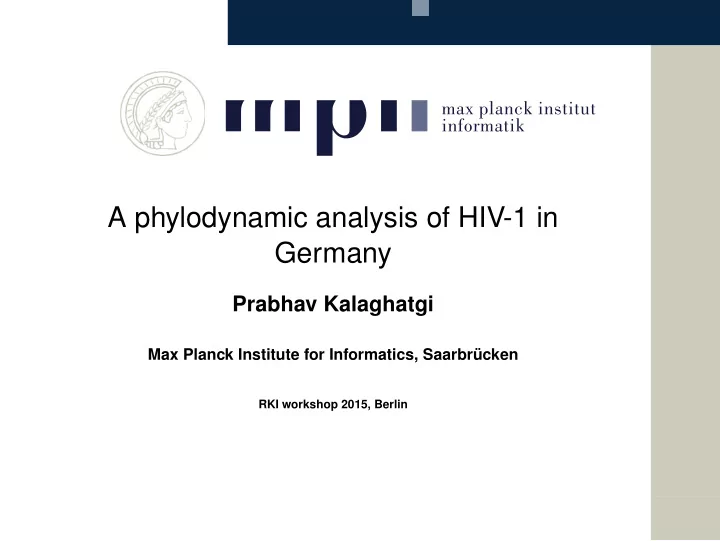

A phylodynamic analysis of HIV-1 in Germany Prabhav Kalaghatgi Max Planck Institute for Informatics, Saarbr¨ ucken RKI workshop 2015, Berlin
Incidence of HIV-1 in Western Europe Figure 2. Number of diagnosed HIV reported infections adjusted for reporting delay, by transmission mode, origin and year, EU/ EEA, 2006–2012 10000 Men who have sex with men 9000 8000 Heterosexual cases, excluding cases from Sub- 7000 Saharan African countries Number of cases 6000 Other/undetermined 5000 4000 Heterosexual cases from sub- Saharan African countries 3000 2000 Injecting drug use 1000 0 Mother-to-child transmission 2006 2007 2008 2009 2010 2011 2012 Year of diagnosis Source: Country reports from Austria, Belgium, Bulgaria, Croatia, Cyprus, Czech Republic, Denmark, Finland, France, Germany, Greece, Hungary, Iceland, Ireland, Latvia, Lithuania, Luxembourg, Malta, Netherlands, Norway, Portugal, Romania, Slovakia, Slovenia, Sweden and United Kingdom. ECDC. Annual epidemiological report 2014. Prabhav Kalaghatgi 2/14
Motivation HIV incidence is not reducing and the epidemic needs to be monitored. Prabhav Kalaghatgi 3/14
Motivation HIV incidence is not reducing and the epidemic needs to be monitored. Viruses sampled from patients sharing a transmission event are closely related. Prabhav Kalaghatgi 3/14
Motivation HIV incidence is not reducing and the epidemic needs to be monitored. Viruses sampled from patients sharing a transmission event are closely related. Viral sequence data collected from patients can help reconstruct transmission clusters. Prabhav Kalaghatgi 3/14
Patient data 2349 patients from Seroconverter cohort (SC) 5283 patients from RESINA cohort 2000 Patients Cohort RESINA SC 1000 0 HET IVDA MSM Other/Unknown factor(InfectionRoute) Prabhav Kalaghatgi 4/14
Sequence data 753 nt of pol gene sites under selection removed (WHO list) predominantly subtype B (COMET) 300 200 Patients Cohort RESINA SC 100 0 1995 2000 2005 2010 2015 Sampling date Prabhav Kalaghatgi 5/14
Identifying transmission clusters Set of individuals that are part of the same transmission chain. A 75 89 B 100 C D E 76 F 1000 bootstrap phylogenetic 56 G 0.18 64 92 H 75 0.16 trees using FastTree I 86 0.14 J 0.12 K 0.10 L Clusters identified as follows: 45 0.08 56 M 0.06 N 73 1. Partition tree into clades at O 0.04 50 P 0.02 11 Q 90 % support 29 0 25 R 28 S 43 2. Add edges between patients T 29 83 U 42 V in same clade if seq. dist 91 W X 52 less than 0.03 sub/site Y 91 Z Prosperi et al. Nat. Commun. ; 2011 Prabhav Kalaghatgi 6/14
Cluster size distribution 500 400 Number of clusters 300 200 100 0 2 5 8 11 16 20 25 30 36 53 Transmission cluster size Prabhav Kalaghatgi 7/14
Proportion of RESINA and SC patients in each cluster 60 40 count Cluster size 300 200 100 20 0 0.0 0.4 0.8 Proportion of patients from RESINA Prabhav Kalaghatgi 8/14
Recommend
More recommend